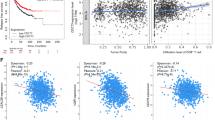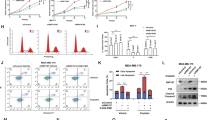Abstract
Tat-interacting protein of 60 kDa (TIP60) is an essential lysine acetyltransferase implicated in transcription, DNA damage response and apoptosis. TIP60 protein expression is reduced in cancers. In cervical cancers, human papillomavirus (HPV) E6 oncogene targets cellular p53, Bak and some of the PDZ domain-containing proteins for proteasome-mediated degradation through E6AP ligase. Recently, E6 oncogene from high-risk and low-risk categories was also shown to target TIP60. However, the molecular mechanisms and whether destabilization of TIP60 contributes to HPV E6-mediated transformation remain unanswered. Our proteomic analyses revealed EDD1 (E3 identified by differential display), an E3 ligase generally overexpressed in cancers as a novel interacting partner of TIP60. By investigating protein turnover and ubiquitination assays, we show that EDD1 negatively regulates TIP60’s stability through the proteasome pathway. Strikingly, HPV E6 uses this function of EDD1 to destabilize TIP60. Colony-formation assays and soft agar assays show that gain of function of TIP60 or depletion of EDD1 in HPV-positive cervical cancer cells significantly inhibits cell growth in vitro. This phenotype is strongly supported by the in-vivo studies where re-activation of TIP60 in cervical cancer cells dramatically reduces tumor formation. In summary, we have discovered a novel ligase through which E6 destabilizes TIP60. Currently, in the absence of an effective therapeutic vaccine for malignant cervical cancers, cervical cancer still remains to be a major disease burden. Hence, our studies implying a distinct tumor suppressor role for TIP60 in cervical cancers show that reactivation of TIP60 could be of therapeutic value.
This is a preview of subscription content, access via your institution
Access options
Subscribe to this journal
Receive 50 print issues and online access
$259.00 per year
only $5.18 per issue
Buy this article
- Purchase on Springer Link
- Instant access to full article PDF
Prices may be subject to local taxes which are calculated during checkout







Similar content being viewed by others
References
Utley RT, Cote J . The MYST family of histone acetyltransferases. Curr Topics Microbiol Immunol 2003; 274: 203–236.
Col E, Caron C, Chable-Bessia C, Legube G, Gazzeri S, Komatsu Y et al. HIV-1 Tat targets Tip60 to impair the apoptotic cell response to genotoxic stresses. EMBO J 2005; 24: 2634–2645.
Fazzio TG, Huff JT, Panning B . An RNAi screen of chromatin proteins identifies Tip60-p400 as a regulator of embryonic stem cell identity. Cell 2008; 134: 162–174.
Ikura T, Ogryzko VV, Grigoriev M, Groisman R, Wang J, Horikoshi M et al. Involvement of the TIP60 histone acetylase complex in DNA repair and apoptosis. Cell 2000; 102: 463–473.
Sapountzi V, Logan IR, Robson CN . Cellular functions of TIP60. Int J Biochem Cell Biol 2006; 38: 1496–1509.
Squatrito M, Gorrini C, Amati B . Tip60 in DNA damage response and growth control: many tricks in one HAT. Trends Cell Biol 2006; 16: 433–442.
Sterner DE, Berger SL . Acetylation of histones and transcription-related factors. Microbiol Mol Biol Rev 2000; 64: 435–459.
Jha S, Shibata E, Dutta A . Human Rvb1/Tip49 is required for the histone acetyltransferase activity of Tip60/NuA4 and for the downregulation of phosphorylation on H2AX after DNA damage. Mol Cell Biol 2008; 28: 2690–2700.
Jha S, Dutta A . RVB1/RVB2: running rings around molecular biology. Mol Cell 2009; 34: 521–533.
Kusch T, Florens L, Macdonald WH, Swanson SK, Glaser RL, Yates JR 3rd et al. Acetylation by Tip60 is required for selective histone variant exchange at DNA lesions. Science 2004; 306: 2084–2087.
Lee MT, Leung YK, Chung I, Tarapore P, Ho SM . Estrogen receptor beta (ERbeta1) transactivation is differentially modulated by the transcriptional coregulator Tip60 in a cis-acting element-dependent manner. J Biol Chem 2013; 288: 25038–25052.
Mahajan MA, Stanley FM . Insulin-activated Elk-1 recruits the TIP60/NuA4 complex to increase prolactin gene transcription. Mol Cell Endocrinol 2014; 382: 159–169.
Sun Y, Xu Y, Roy K, Price BD . DNA damage-induced acetylation of lysine 3016 of ATM activates ATM kinase activity. Mol Cell Biol 2007; 27: 8502–8509.
Tang Y, Luo J, Zhang W, Gu W . Tip60-dependent acetylation of p53 modulates the decision between cell-cycle arrest and apoptosis. Mol Cell 2006; 24: 827–839.
Hu Y, Fisher JB, Koprowski S, McAllister D, Kim MS, Lough J . Homozygous disruption of the Tip60 gene causes early embryonic lethality. Dev Dyn 2009; 238: 2912–2921.
Gorrini C, Squatrito M, Luise C, Syed N, Perna D, Wark L et al. Tip60 is a haplo-insufficient tumour suppressor required for an oncogene-induced DNA damage response. Nature 2007; 448: 1063–1067.
Legube G, Linares LK, Lemercier C, Scheffner M, Khochbin S, Trouche D . Tip60 is targeted to proteasome-mediated degradation by Mdm2 and accumulates after UV irradiation. EMBO J 2002; 21: 1704–1712.
Sho T, Tsukiyama T, Sato T, Kondo T, Cheng J, Saku T et al. TRIM29 negatively regulates p53 via inhibition of Tip60. Biochim Biophys Acta 2011; 1813: 1245–1253.
Kaidi A, Jackson SP . KAT5 tyrosine phosphorylation couples chromatin sensing to ATM signalling. Nature 2013; 498: 70–74.
Zheng H, Seit-Nebi A, Han X, Aslanian A, Tat J, Liao R et al. A posttranslational modification cascade involving p38, Tip60, and PRAK mediates oncogene-induced senescence. Mol Cell 2013; 50: 699–710.
Callaghan MJ, Russell AJ, Woollatt E, Sutherland GR, Sutherland RL, Watts CK . Identification of a human HECT family protein with homology to the Drosophila tumor suppressor gene hyperplastic discs. Oncogene 1998; 17: 3479–3491.
Mansfield E, Hersperger E, Biggs J, Shearn A . Genetic and molecular analysis of hyperplastic discs, a gene whose product is required for regulation of cell proliferation in Drosophila melanogaster imaginal discs and germ cells. Dev Biol 1994; 165: 507–526.
Henderson MJ, Russell AJ, Hird S, Munoz M, Clancy JL, Lehrbach GM et al. EDD, the human hyperplastic discs protein, has a role in progesterone receptor coactivation and potential involvement in DNA damage response. J Biol Chem 2002; 277: 26468–26478.
Henderson MJ, Munoz MA, Saunders DN, Clancy JL, Russell AJ, Williams B et al. EDD mediates DNA damage-induced activation of CHK2. J Biol Chem 2006; 281: 39990–40000.
Eblen ST, Kumar NV, Shah K, Henderson MJ, Watts CK, Shokat KM et al. Identification of novel ERK2 substrates through use of an engineered kinase and ATP analogs. J Biol Chem 2003; 278: 14926–14935.
Alpsoy A, Yasa S, Gunduz U . Etoposide resistance in MCF-7 breast cancer cell line is marked by multiple mechanisms. Biomed Pharmacother 2014; 68: 351–355.
Bradley A, Zheng H, Ziebarth A, Sakati W, Branham-O'Connor M, Blumer JB et al. EDD enhances cell survival and cisplatin resistance and is a therapeutic target for epithelial ovarian cancer. Carcinogenesis 2014; 35: 1100–1109.
Mori Y, Sato F, Selaru FM, Olaru A, Perry K, Kimos MC et al. Instabilotyping reveals unique mutational spectra in microsatellite-unstable gastric cancers. Cancer Res 2002; 62: 3641–3645.
Chou S . Diverse cytomegalovirus UL27 mutations adapt to loss of viral UL97 kinase activity under maribavir. Antimicrob Agents Chemother 2009; 53: 81–85.
Li R, Zhu J, Xie Z, Liao G, Liu J, Chen MR et al. Conserved herpesvirus kinases target the DNA damage response pathway and TIP60 histone acetyltransferase to promote virus replication. Cell Host Microbe 2011; 10: 390–400.
Reitsma JM, Savaryn JP, Faust K, Sato H, Halligan BD, Terhune SS . Antiviral inhibition targeting the HCMV kinase pUL97 requires pUL27-dependent degradation of Tip60 acetyltransferase and cell-cycle arrest. Cell Host Microbe 2011; 9: 103–114.
Awasthi S, Sharma A, Wong K, Zhang J, Matlock EF, Rogers L et al. A human T-cell lymphotropic virus type 1 enhancer of Myc transforming potential stabilizes Myc-TIP60 transcriptional interactions. Mol Cell Biol 2005; 25: 6178–6198.
Jha S, Vande Pol S, Banerjee NS, Dutta AB, Chow LT, Dutta A . Destabilization of TIP60 by human papillomavirus E6 results in attenuation of TIP60-dependent transcriptional regulation and apoptotic pathway. Mol Cell 2010; 38: 700–711.
Kimura A, Horikoshi M . Tip60 acetylates six lysines of a specific class in core histones in vitro. Genes Cells 1998; 3: 789–800.
Tomaic V, Pim D, Thomas M, Massimi P, Myers MP, Banks L . Regulation of the human papillomavirus type 18 E6/E6AP ubiquitin ligase complex by the HECT domain-containing protein EDD. J Virol 2011; 85: 3120–3127.
Honda Y, Tojo M, Matsuzaki K, Anan T, Matsumoto M, Ando M et al. Cooperation of HECT-domain ubiquitin ligase hHYD and DNA topoisomerase II-binding protein for DNA damage response. J Biol Chem 2002; 277: 3599–3605.
Huibregtse JM, Scheffner M, Beaudenon S, Howley PM . A family of proteins structurally and functionally related to the E6-AP ubiquitin-protein ligase. Proc Natl Acad Sci USA 1995; 92: 5249.
Gupta A, Jha S, Engel DA, Ornelles DA, Dutta A . Tip60 degradation by adenovirus relieves transcriptional repression of viral transcriptional activator EIA. Oncogene 2013; 32: 5017–5025.
Sun Y, Jiang X, Price BD . Tip60: connecting chromatin to DNA damage signaling. Cell Cycle 2010; 9: 930–936.
Huibregtse JM, Scheffner M, Howley PM . Cloning and expression of the cDNA for E6-AP, a protein that mediates the interaction of the human papillomavirus E6 oncoprotein with p53. Mol Cell Biol 1993; 13: 775–784.
Thomas M, Banks L . Inhibition of Bak-induced apoptosis by HPV-18 E6. Oncogene 1998; 17: 2943–2954.
Ohshima R, Ohta T, Wu W, Koike A, Iwatani T, Henderson M et al. Putative tumor suppressor EDD interacts with and up-regulates APC. Genes Cells 2007; 12: 1339–1345.
Hay-Koren A, Caspi M, Zilberberg A, Rosin-Arbesfeld R . The EDD E3 ubiquitin ligase ubiquitinates and up-regulates beta-catenin. Mol Biol Cell 2011; 22: 399–411.
Metzger MB, Hristova VA, Weissman AM . HECT and RING finger families of E3 ubiquitin ligases at a glance. J Cell Sci 2012; 125: 531–537.
Krishna Subbaiah V, Massimi P, Boon SS, Myers MP, Sharek L, Garcia-Mata R et al. The invasive capacity of HPV transformed cells requires the hDlg-dependent enhancement of SGEF/RhoG activity. PLoS Pathog 2012; 8: e1002543.
Frank SR, Parisi T, Taubert S, Fernandez P, Fuchs M, Chan HM et al. MYC recruits the TIP60 histone acetyltransferase complex to chromatin. EMBO Rep 2003; 4: 575–580.
Acknowledgements
We thank the members of the Jha laboratory for helpful discussion and comments. We thank Drs Neerja Karnani (Singapore Institute for Clinical Science, A*STAR), Daniel G Tenen (Cancer Science Institute of Singapore) and Yoshiaki Ito (Cancer Science Institute of Singapore) for their comments on the manuscript. We thank Drs Shojiro Kitajima for soft agar assays, Amit Kumar Pandey for real-time PCR and Tan Boon Toh for tumor quantification analysis. SJ was supported by grants from the National Research Foundation Singapore and the Singapore Ministry of Education under its Research Centers of Excellence initiative to the Cancer Science Institute of Singapore (R-713-006-014-271), National Medical Research Council (NMRC CBRG-NIG BNIG11nov001) and Ministry of Education Academic Research Fund (MOE AcRF Tier 1 T1-2012 Oct-04). EKC was supported by grants from the National Research Foundation Cancer Science Institute of Singapore RCE Main Grant, National Medical Research Council (NMRC CBRG-NIG BNIG12nov017) and Ministry of Education Academic Research Fund (MOE AcRF Tier 1 T1-2012 Oct-11).
Author information
Authors and Affiliations
Corresponding author
Ethics declarations
Competing interests
The authors declare no conflict of interest.
Additional information
Supplementary Information accompanies this paper on the Oncogene website
Rights and permissions
About this article
Cite this article
Subbaiah, V., Zhang, Y., Rajagopalan, D. et al. E3 ligase EDD1/UBR5 is utilized by the HPV E6 oncogene to destabilize tumor suppressor TIP60. Oncogene 35, 2062–2074 (2016). https://doi.org/10.1038/onc.2015.268
Received:
Revised:
Accepted:
Published:
Issue Date:
DOI: https://doi.org/10.1038/onc.2015.268
This article is cited by
-
Potential role of human papillomavirus proteins associated with the development of cancer
VirusDisease (2022)
-
Beyond K48 and K63: non-canonical protein ubiquitination
Cellular & Molecular Biology Letters (2021)
-
E3 ubiquitin ligase UBR5 promotes pancreatic cancer growth and aerobic glycolysis by downregulating FBP1 via destabilization of C/EBPα
Oncogene (2021)
-
Cancer exosomes induce tumor innervation
Nature Communications (2018)
-
UBR5 Contributes to Colorectal Cancer Progression by Destabilizing the Tumor Suppressor ECRG4
Digestive Diseases and Sciences (2017)



